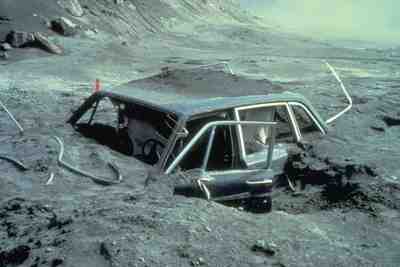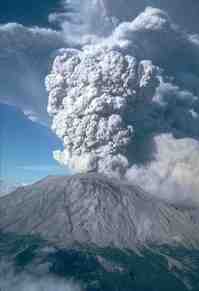Faculty Expert: Volcanologist Kathy Cashman is head of the Department of Geological Sciences.

Q: It's been 30 years since Mt. St. Helens erupted -- what's been the long-term impact for both volcano research and for the cultural memory of the Northwest?
A: My research has taken me to places all over the world, from New Zealand to Antarctica, but Mt. St. Helens is a volcano I keep coming back to because I know it so intimately. Whenever we have a new idea or a new technique, Mt. St. Helens is a convenient place to test it out because the eruption made this volcano such a familiar and well-documented system.
But it wasn't until I began to teach at the UO, several years after the eruption, that I realized how meaningful it was to Northwesterners. I was surprised that any time I mentioned to someone that I was a volcanologist, they'd immediately mention Mt. St. Helens and have a story about where they were and what they were doing when it erupted. It became clear to me that it was one of those events that tied the region together with a common memory, the same way my generation feels about the Kennedy assassination or when Neil Armstrong walked on the moon.
Oral Traditions and Traumatic Events
In the last five or six years, I've become more interested in how ancient cultures have woven volcanoes and eruptions into their oral traditions and cultural histories. People back then weren't as mobile or as insulated from the landscape as we are today, and they clearly had stronger memories of environmental disasters. The Klamath, for example, still have stories about eruptions that are very stylized but very specific about the sequence of events, which seem to make sense to us studying the evidence thousands of years later.
The tribes around Mt. Rainier, a mountain notorious for mudslides, had stories about the peaks being inhabited by giants that would throw rocks at people who trespassed on their land. So they stayed away from the mountains, and if you think about it, that's a great method of land use planning.
I think there are similarities between those native oral traditions and what Mt. St. Helens has inspired in our own culture, everything from paintings to country ballads. It's part of how we deal with the trauma of these events.
But it's still something that we're struggling with in modern times. We have problems dealing with and preparing for natural disasters because we're lacking long-term cultural memory of traumatic events, whether they are floods, landslides or hurricanes. But the 1980 eruption of Mt. St. Helens has the potential to occupy a large space in our cultural memory.
Mt. St. Helens already occupies a very large space in terms of scientific knowledge. We know so much about it that it's now a place we go to test new ideas and methods. In that way, it serves the same role as a model organism does for biologists.
Monumental Scientific Importance
Progress in the field of volcanology has always been inextricably tied to historic, cataclysmic eruptions. The Mt. St. Helens eruption was monumentally important because it was the first time an explosive eruption took place in a country with the means and the manpower to fully document and record it as it was happening. This was effectively the dawn of modern quantitative monitoring of explosive volcanoes. Previously, most of our techniques had been developed in Hawaii where the volcanoes have large lava flows that ooze slowly over long periods of time.
The signature event of the Mt. St. Helens eruption was the collapse of the north flank of the volcano (what's called a debris avalanche) and then the lateral blast from the north. We knew about this type of eruption but thought it was pretty uncommon. But when we saw how the debris avalanche resulted in this very distinctive hummocky landscape, it was as if light bulbs went off in all of our heads because it looked familiar. Personally, I had seen similar deposits while doing my graduate work in New Zealand, and you can see the same sort of terrain off Interstate 5 just west of Mount Shasta. Around the world, we were all saying, "Oh, that's what those weird deposits are."
 Previous to that, we had a narrow vision of how volcanoes evolved, either by blowing their top off or by gradually growing through consistent, slow lava flows. But we've since realized the wholesale collapse of one side is an important part of a volcano's history. It's a different kind of hazard and different kind of process, and we have to be conscious of that because its impact is so instantaneous.
Previous to that, we had a narrow vision of how volcanoes evolved, either by blowing their top off or by gradually growing through consistent, slow lava flows. But we've since realized the wholesale collapse of one side is an important part of a volcano's history. It's a different kind of hazard and different kind of process, and we have to be conscious of that because its impact is so instantaneous.
Photo: Ten miles from Mt. St. Helens, ash from the eruption buried photographer Reid Blackburn's car. Photos courtesy U.S. Geological Survey.
Did Not See That Coming
The eruption was also very sobering because there was no indication on the morning of May 18, 1980, that it was coming. Previously the most common way to predict activity was seismic monitoring, and this volcano was very quiet seismically before the eruption.
The fact that the peak was docile before such an explosive event was a stark reminder of just how unpredictable volcanoes can be. Even today, as much as we can measure with GPS and satellite imagery, there's still a lot going on beneath the crust that we can't observe. Volcanoes thus remain incredibly temperamental and tempestuous creatures, even to us who know them best.
We have developed some useful tools, however. The depth to which we were able to study the eruption and its aftermath led to a number of pioneering techniques in monitoring and prediction, and it created a new framework of questions for us to explore and try to answer. The people who worked at Mt. St. Helens developed prediction models that were highly successful in helping to control later 1980s volcano crises in Japan and the Philippines.
Like many of my colleagues, the eruption really changed the course of my career. I've worked on projects around the world, but I've continued working on topics related to Mt. St Helens. Because of what it's meant to my field, I'm just always going to be drawn back there.
Marking the May 18 Anniversary
Kathy Cashman will deliver a talk commemorating the 30th anniversary of the Mt. St. Helens eruption.
Where: Knight Law Center, Room 175
When: Tuesday, May 4, 7 p.m.
Free and open to the public. For details, visit natural-history.uoregon.edu.
Got your own tale to tell? Where were you when Mt. St. Helens blew? Share your story on the Cascade website.


 When the volcano erupted, a UO professor discovered that local residents consoled themselves through song.
When the volcano erupted, a UO professor discovered that local residents consoled themselves through song.
 Join UO neuroscientists as they bring the host of the PBS series, The Human Spark into their brain research lab.
Join UO neuroscientists as they bring the host of the PBS series, The Human Spark into their brain research lab. Temple Grandin, perhaps the world's best known person with autism, drew an overflow crowd to her UO talk.
Temple Grandin, perhaps the world's best known person with autism, drew an overflow crowd to her UO talk.

 Watch a slideshow about Elena Rodina's journalistic globetrotting, from the Arctic Circle to Cuba.
Watch a slideshow about Elena Rodina's journalistic globetrotting, from the Arctic Circle to Cuba.